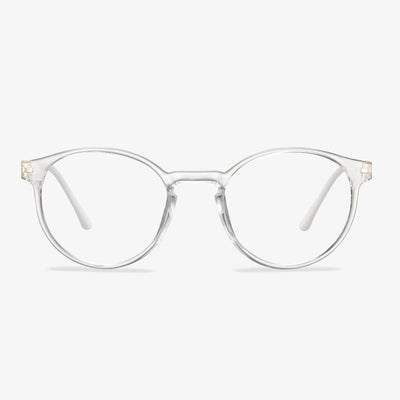Polarized vs non-polarized sunglasses
-
Non-polarized sunglasses generally only have the two basic functions of shielding strong light and filtering ultraviolet rays, and their efficiency in filtering ultraviolet rays is low. In our daily life, in addition to strong light and ultraviolet light, when light passes through uneven roads, water surfaces, and other places, irregular diffuse reflection light will be generated, which will cause blurred vision and fatigue in the eyes.
-
Polarized sunglasses can filter out this kind of light, only absorb the reflected light of the object itself, truly present what you see, make the field of vision clearer, and reduce visual fatigue. In addition, polarized sunglasses have a 99% blocking rate of ultraviolet rays due to their high-efficiency filter layer, which can effectively reduce the damage of ultraviolet rays to the eyes.
-
When judging whether the sunglasses are polarized lenses, you can rotate the sunglasses up to 45° clockwise. If the color of the lens changes at this time, and the color of the sunglasses returns to normal after turning the sunglasses back to the original position, then it can be judged that the sunglasses are polarized. And if you can’t see the change in the color of the sunglasses lens no matter how you turn it, then you can judge that the sunglasses are not polarized.
Aluminum Night Driving Glasses
These night vision glasses feature advanced HD technology. The aluminum frame is lightweight, allowing you to comfortably wear your driving glasses and reduce glare for safe driving. Because the lenses are yellow, these glasses act as night vision goggles to reduce glare, reflections, and their negative effects, while improving and brightening the visual area. Polarized lenses have a special anti-reflective coating that eliminates intense reflected light and reduces glare and scattered reflections. They can double as day and night glasses, improving clarity around the clock.
Different styles of glasses
If the style of new glasses is different from the old glasses, the angles of the glasses are also different. So the new glasses will cause visual differences. The symptoms of dizziness after wearing the new glasses will occur after a short period of time. If you adapt, you should be able to return to normal.
In order to avoid discomfort in wearing glasses due to inaccurate optometry, experts suggest that myopia should choose a professional eye hospital for medical optometry. When the glasses are damaged, they should be replaced in time to avoid injury to the eyes.
Single Vision vs Progressive: What Are Their Differences
In this part, we will show you some differences between single vision and progressive lenses. They differ in several factors, so here we will compare them one by one.
Progressive lenses generally have their reading zones just in the lower half of the lenses, while single vision glasses have the reading power all over the lens. So if you are working on something above your head and you need to see some small details, the progressive lenses will not work. And you can not see through the reading zone in progressive you need to switch to single vision reading glasses.
Single vision glasses are cheap than progressive lenses. Compared to progressive glasses, single vision glasses hold way fewer distortions in the periphery. So, there is no need to customize the lens design to the max. In addition, single vision glasses are often available in the optical store while the progressive often needs to be produced for you. In other words, the delivery time of single vision lenses will be shorter for you.
You can use your progressive glasses optimally just in an upright posture. As soon as you lay down on your couch, this will lead to blurry vision. The reason is your changed position which forces you to look lower through the lenses on the screen. However, with single vision glasses, you can change to an upright position and it would not be a problem anymore. You can position yourself on your couch as comfortably as you want and you can still see clearly with your single vision distance glasses.
Night Driving Glasses Fit Over Prescription Glasses
They have a plastic frame polarized anti-reflective coating Bridge. The ergonomic design of these Peekaco night vision glasses means you can easily wear them over your prescription lenses. Yellow lenses protect your eyes from glare and improve color clarity and optical clarity. Peekaco night vision glasses can be used in a variety of complex environments. It eliminates the high beams and illuminates the ground. On foggy days, it illuminates and clears the field of view. TR90 is a durable material, very flexible and light. Peekaco wraparound sunglasses are flexible enough to be suitable for each face shape.
About the Eyeglasses Depot
EyeglassesDepot.com was founded in 2007 as a new division of our retail designer glasses and sunglasses business. Two laboratory technicians have over 17 years of profession in the field of optometry, eyewear repair, and eyewear sales. The target is to repair more and more glasses and bring them back to life. They include sunglasses and glasses repairing to restore their natural beauty.
What Are Trivex Lenses?
What is Trivex? Trivex lenses were first produced in 2001. Trivex lenses come with several features such as light, impact-resistance, and high-performance strength. Recently, the use of Trivex as ophthalmic lens material has grown in popularity. Lenses made from Trivex material fulfill the same safety standards as those made from polycarbonate.
In addition, because of Trivex’s manufacturing process, plastic lenses sporting Trivex material do not distort vision as much. Trivex lenses offer 100 percent protection from UAV and UAB rays, sharper central vision, and sharper peripheral vision. Trivex was developed for military applications, so it is good for outdoor use. Other benefits include resistance to chemicals and better light refraction.
So, in the following section, we will show you the advantages and disadvantages of the Trivex lenses.











































